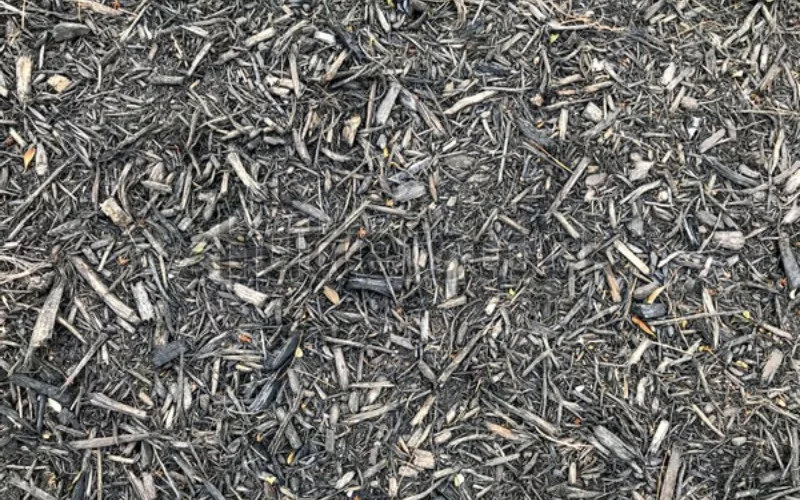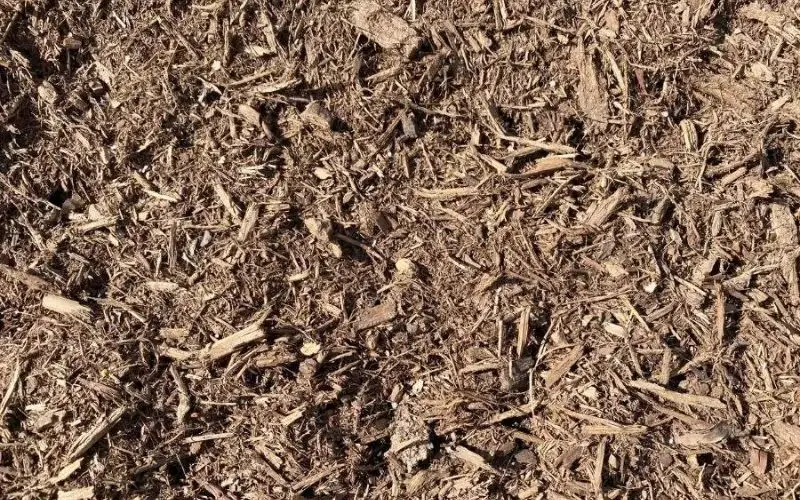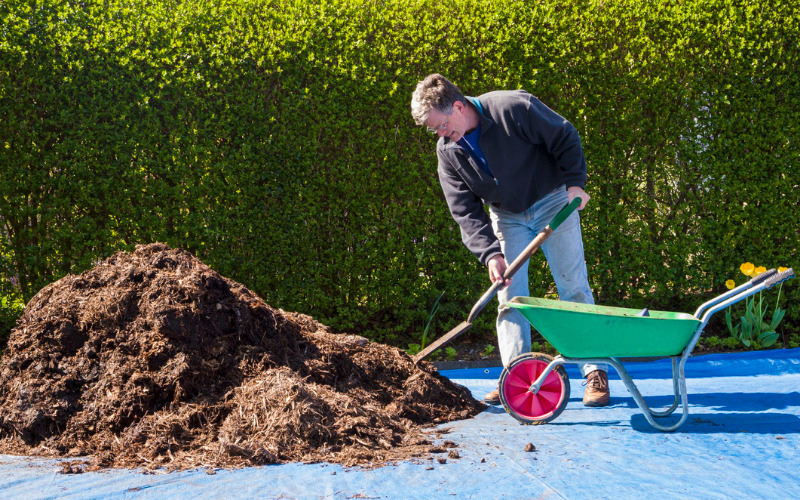We often cover our garden, backyard, and other surfaces around our plants with different materials to create a conducive environment in which they will grow.
This is what mulching is all about, and the materials used are called mulches, and they can be wood chippings, straw, grass, hay, among others.
Mulches are good for the soil because they conserve the moisture and nutrients of the soil they help control weeds and erosion. They also add a rustic kind of beauty to the whole scenery of your backyard.
But over time, the mulches in your backyard get old, change colour, and maybe even begin to decompose, and you might be wondering what to do: remove or reuse them.
You can do either of the two; you can remove and dispose of the mulches if they have stayed for a long time, while you can put them into other uses or add a layer of new mulches on top of them.
Does Mulch Go Bad?
Mulch, like all materials, will deteriorate with time, so mulches will go bad after using them for some time. Remember that all mulch materials are biodegradable; the only thing is that they decompose at different rates.
You might be wondering how to tell if your mulch has gone bad. Here are a few indicators to tell you if your mulch is bad and needs to be changed.
1. Insect Infestation
If you find a lot of crawling insects in your mulch, especially termites, then there is a probability that your mulch is going bad, so you need to change them.
2. Offensive Smell
If your mulch smells like sulphur, vinegar or rotten egg, it is an indicator that they are turning bad. This smell is a result of a lack of oxygen which encourages anaerobic respiration.
3. Mulch Covered in Artillery Fungus
The presence of artillery fungus spores which look like specks of tars on your mulches is a sign that they are going bad. These fungi are harmless to your plants, but they can stain your car and other surfaces.
4. Presence of Slimy Molds
These molds, which can be yellow, red or orange, are quite harmless. However, it is a sign that you need to either aerate or change your mulch.
Will Mulch Attract Termites?

The answer to this question is not a straight yes or no; it needs a lot of explanation. Termites are not attracted to mulches perse; they, however, are linked to mulches because mulches provide a moist environment conducive to termites’ thrive. Hence they are always found on mulches.
Mulches that make your garden moist provide an environment for termites to explore while providing cover from their predators.
So mulches do not directly invite termites to your space. However, they provide the right environment for colony termites to thrive and invade your yard.
To take care of the termite in your mulch, you should get termite-resistant mulch that deters or impedes the growth of the termite colony in your yard.
Mulches made from eucalyptus, California redwood, melaleuca, Cypress heartwood are some examples of mulch materials that can significantly decrease the number of termites on your mulch.
Your best way to decrease the termite colony in your mulch or even prevent them from inhabiting your mulch in the first place is to resort to long-term termite prevention, control and management programme.
Helpful Link: Guide to Prevent Mushroom in Mulch
Should Mulch be Removed Every Year?
Organic mulches are meant to last for up to 6 years if there is very little interference from the elements, but since we cannot control what our mulches are exposed to, mulches can start going bad in a year or two and so must be changed eventually.
Organic mulch decomposes over time, so it will need to be replaced eventually. A typical mulch may last about five years, but this timeframe can decrease depending on the type of mulch, weather conditions, rainfall, sun exposure.
Many factors will determine if you will change your mulch yearly or leave them for a few years. This includes the type of mulch, the amount of rainfall and sun it is exposed to, the area’s climatic condition, and the presence of insects and pests.
What Happens if You Don’t Replace Old Mulch?
Your old mulch will certainly become old no matter the material it is made of, and so you have to remove and replace them. As these mulches age, they begin to decompose, lose some of their bulk, and cannot perform the functions you put them there for.
With old mulch, you will encounter the problem of erosion and weeds in your space because the mulches are decomposing. Their color, too, will begin to fade, thereby leaving you with a drab yard.
How Do I Get Rid of Old Mulch?

If your mulch can no longer perform the function you put them there for, you will need to get rid of them. The steps below will show you how to remove the old mulch in your yard.
Step 1: Wear a hand glove because you will be using your hand to remove the mulch from the ground, and you do not want to contract a disease because mulches are also pathogens that carry disease-causing microbes. You don’t remove the old mulch at once, but you can do it over several weeks.
Step 2: At the garden edges or other points where the mulches are stuck, run the blade of an edging tool around the edges of the garden to loosen them up and remove them.
Step 3: A rake should be used to break the clump of mulches that you just unstuck with the edging tool, then pile the mulches. You should perform this task very careful so that you don’t destroy some of your plants. You can prevent damaging or uprooting your plants by not raking around your plants.
Step 4: Use a shovel to scoop out the mulches that you just piled up to a container or a tarpaulin
Step 5: You can now use your hand (I hope you still have your gloves on) to brush away the mulches all around the plants and then put them in your tarp or container.
Step 6: For the smaller bits that are around, use a leaf blower and blow them away. Your leaf blower should just be used for a few minutes because it can dry out the soil.
Step 7: Last step is to dispose of all the old mulch you have collected on the tarp or inside a container. If untreated, it is safe to dispose of it in the trash or a yard waste bin and 100% vegetative. We will learn more about this step ahead.
Step 8: You can now dispose of the mulches you just collected. You can safely dispose of them in yard waste or trash if you know that the old mulch was not treated and that they are vegetative.
Recommended: How to Get Rid of Mushrooms in Mulch.
Do You Remove Old Mulch Before Putting in New?
Expert green thumbs contend that getting rid of last year’s mulch is completely unnecessary. Mulch gradually breaks down, adding beneficial nutrients and other organic matter to the soil. Removing pre-existing mulch every year only ends up being extra work and a needless expense.
It is really up to you if you want to remove all the old mulch and replace them completely with new ones or if you want to top up with new ones on the old ones that are running thin.
The debate on which s better: completely removing old mulch or adding new mulch on the old ones is still raging amongst Expert gardeners.
While some believe that the old mulch should be left in the soil to continue to decompose and add nutrients to the soil, which makes complete removal of mulches a needless waste of time, effort and money.
While those who favour the complete removal of mulch and replacing them with new ones support their argument that old mulch can harbour fungi, bacteria, and other pests that can be harmful to the plants in your garden, they also believe that the odour it gives off, and its drab look is a put off for them.
So, if you know that your mulch is infested with pathogens, you will need to remove and replace them completely. If, however, your mulch is okay but looks dull and faded, and you don’t mind the sight, then rake them as you add new mulch to them.
What To Do With Old Mulch
Even though your mulch has aged a few years, you can put them to beneficial use. However, you decide to reuse or repurpose your old mulch, make sure that it is free of larvae of disease-carrying organisms so that they don’t continue their cycles in your space.
You can revive your faded mulch by using a mulch renovator to add more colour and glow to them, and hence you will not need to remove them. All you have to do is use a rake to turn the old mulches to aerate it.
You can put your old mulch in purpose like adding them to your composting bin and turning them into compost. You can also mix up the old mulch and the topsoil because they are natural, organic fertilizers.
These old mulches release nutrients and also aerate the soil, but they must be only disease-free mulches. You should not add dyed or plastic mulch into your compost pile or mix them up into your soil.
How Often Should You Replace Mulching?
The frequency at which you replace your mulch depends on how well you maintain them. If you follow a good maintenance regime, you will need to replace your mulch less frequently, maybe once in 5 years.
But if you do not take the maintenance of your mulch serious, then you will need to replace your mulch yearly or once in 2 years.
Ideally, you should replace your mulch when you start seeing signs of discoloration, soil erosion and decomposition.
Wind, rain and human traffic can remove some of the mulches, which means you will have to add more to cover the soil properly.
So you will need to change your mulch more frequently if you experience heavy rain and windy condition and if the decomposition of organic matter in your garden is speeded up.
Conclusion
So if you have old mulch in your garden and do not know what to do with them, you can add an inch of new mulch and then continue using them.
You can also put them into other uses like adding them into your compost bin and making compost out of them, or you can even mix them up with the topsoil on your garden so that they release nutrients slowly for your plants to thrive.
You May Also Like:
- Mushrooms Growing in Mulch
- Should I Grind My Compost?
- 5 Best Composting Grinder for Home Use
- Why Am I Getting Mushroom in My Mulch?
- How to Find Clay in Your Backyard (4 Quick Steps)
We trust this article helped you understand What To Do With Old Mulch. You may also want to check out How to Get Rid of Mushrooms in Mulch.
Thanks for taking the time to read our article, and we hope you find it helpful. Would you mind leaving a comment below if you have any suggestions?
Kindly reach out to people by sharing this post on social media.
If you liked this article, then please follow us on Facebook, Instagram, and Pinterest.


